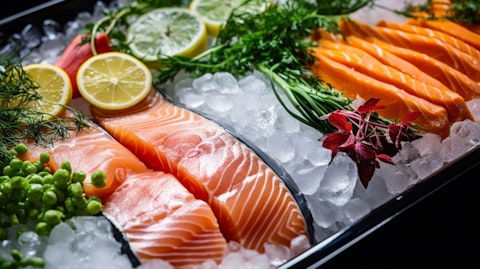Nomad Foods Limited (NYSE:NOMD) Q2 2025 Earnings Call Transcript August 6, 2025
Nomad Foods Limited beats earnings expectations. Reported EPS is $0.4712, expectations were $0.44.
Operator: Greetings, and welcome to the Nomad Foods Second Quarter 2025 Question and Answer Session. [Operator Instructions] As a reminder, this conference is being recorded. I would now like to turn the call over to your host, Jason English, Head of Investor Relations. Thank you. You may now begin.
Jason English: Good morning, everyone, and thank you for joining us today. I hope everyone has had chance to read our press release and listen to our prerecorded management remarks, both of which are available on our website. In addition, we have posted a transcript of the prerecorded remarks and the accompanying presentation. At the conclusion of today’s live Q&A session, we’ll also post an audio replay of this call. Please note that during today’s Q&A session, we may make forward-looking statements that are based on our view of the company’s prospects, expectations and intentions at this time. Actual results may differ due to risks and uncertainties, which are discussed in our press release, our filings with the SEC and in our investor presentation, which includes cautionary language.

We will also discuss non-IFRS financial measures during the call today. These non-IFRS financial measures should not be considered a replacement for and should be read together with IFRS results. Users can find the IFRS to non-IFRS reconciliations within our earnings release and the appendices at the end of the slide presentation available on our website. Please note that certain financial information within this presentation represents adjusted figures. All adjusted figures have been adjusted primarily for, when applicable, share-based payment expenses and related employer payroll taxes, exceptional items and foreign currency translation charges or gains. Unless otherwise noted, comments from here will refer to those adjusted numbers. Joining me today are Nomad Foods CEO, Stefan Descheemaeker; and CFO, Ruben Baldew.
Now let’s get started with our first question. Operator?
Q&A Session
Follow Nomad Foods Ltd (NYSE:NOMD)
Follow Nomad Foods Ltd (NYSE:NOMD)
Receive real-time insider trading and news alerts
Operator: [Operator Instructions] The first question comes from Andrew Lazar with Barclays.
Andrew Lazar: And thanks again to you guys for putting out the published prepared remarks. That’s actually very helpful to us in sort of getting through the results pretty quickly. Maybe, Stefan, just as a starting point, I guess what gives you the confidence and sort of the visibility that you finally called the full year guidance low enough given the pattern more recently of missing and guiding lower over the past year?
Stefan Descheemaeker: Thanks, Andrew. It’s a great question. And obviously, it’s a very important question for us. And let me stand back for just a second. I’ve been with the company for 10 years since we started and quite frankly, to your point, I don’t think we’ve been accustomed to this. So it’s really something that we need to take into consideration with the guidance. The second point is, at the same time, over the last 10 years, with all the disruptions we’ve been through, I think we’ve been very good at learning from all these events. So let me first start with what I think is self-inflicted, and I’m really taking this on me. I think we were too optimistic with our ERP implementation. That’s the first piece. And the second level, we also had an excess inventory in Q1 that, quite frankly, we did a poor job at anticipating it.
And quite frankly, I’m taking these 2 points with me. I think the lesson, though is in terms of our ERP, we’re slowing down the program just to make sure that we’re taking the right level in terms of risk digestion of all the things we’re doing, which is absolutely fundamental. And I’m very pleased with what the team is doing at this stage. And in terms of excess inventory and all these things between sell-in and sellout, quite frankly, what I’ve seen is the team is doing a much, much, much better job at reading the visibility between both and let’s say, the dynamics between both, especially during these volatile times. So that’s the first piece, which is really, quite frankly, I would call self-inflicted. The second piece is especially in Q2 is the weather.
Well, for your information, June in Western Europe is — was the hottest June on record — in record in the region. Some differences, obviously, let’s say, Nordics was a bit milder, but you take countries like France, like U.K., like Belgium, while the numbers, especially between, let’s say, mid-June to mid-July, well, you have numbers around minus 5%, minus 6%, minus 7% for the market as such, where, quite frankly, we would have expected to be in the region of 1.5% to 2%. At the same time, we’ve been able to regain market to gain market share, especially in volume, which is good. And despite the fact that our categories are especially fish and vegetables are undertrading, especially during the hot weather but that’s not obviously that’s not enough.
So for us, also the learning here is, okay, what can we do to make sure that we have a better summer assortment because basically, we don’t know whether it’s going to be a pattern for the future, but we need to be ready and to hedge our bet for the future for 2026 and beyond. And we have — the teams are preparing things in terms of potatoes in terms of, let’s say, natural fish and other things that I will mention later. So as to make sure that basically we have either obviously an additional opportunity for the future, which we always did and obviously, also how to hedge our bet versus what can happen in the future. We don’t know that piece. Now obviously, with all these things and with all this volatility, yes, we have decided to take a wider range to take into account potential risk, obviously, mostly around additional continuing heat wave.
We haven’t seen it yet. Let’s say, let’s face it, when it’s interesting to see that first part of July was very hot, and we’ve seen the numbers immediately in terms of sellout. And the second half was better, better from our standpoint, obviously, which means milder weather. And we’ve seen immediately the correlation between the two. But this is why we’re taking this range. Obviously, if there is no additional heat wave or something is similar, obviously, we — we’re not going to touch the lower end, but that’s why we took a wider range. And I think it was not an easy decision. We understand that. But at the same time, I definitely believe it’s the right decision.
Andrew Lazar: Great. And then maybe as a follow-up, the midpoint of organic growth guidance for the year would point to about 50 basis points of organic sales growth in the second half. If 3Q ultimately returns to some growth, as I think you hope it does, that would suggest, I guess, not a whole lot of improvement between 3Q and 4Q. Am I thinking about that the right way? Or I would think maybe some of the sellout demand kind of build sequentially as you go through the year, but I’m just curious on your thoughts there.
Ruben Sewnarain Baldew: Yes. Thank you, Andrew. Let me take that. So you’re right. Let me also for the sake of the benefit for the whole group. So our range between 0 and minus 2% assumes in H2 between a plus 2.5% and a minus 1.5% and indeed the midpoint is [2.5% ]. You’re right that normally speaking, we should see growth in quarter 3, but also to be clear on what Stefan just said, and I know the optics of the weather, but just some data points. We’ve seen the market in quarter 2 in volume minus 1%. With Easter, we expect that to be plus 1%, 1.5%, including the Easter effect. We don’t have all the sellout data yet for all markets, but for the market for which we have it from mid-June to mid-July, we’ve seen market at minus 5.5%.
And we’ve seen that to Stefan’s point, immediately reflected [indiscernible] so we love committing to growth in quarter 3. It depends on what Stefan just said, what are we seeing through the course of the quarter. Yes, and if there’s growth in quarter 3, your mathematics are right and the midpoint assumes a bit more of a prudent assumption for quarter 4. But we’re also very conscious that we’ve now lowered the guidance 2x, and we will avoid that happening again.
Operator: Our next question comes from Steve Powers with Deutsche Bank.
Stephen Robert R. Powers: Reuben, just to confirm on your 3Q commentary, you are — fully understand the marketplace trends into the quarter and the dynamics, but you are lapping the ERP supply disruption of a year ago. I think that was about a 2.5 point negative to last year’s sales versus consumption. Just want to clarify that and make sure that, that comparison still factors into your outlook.
Ruben Sewnarain Baldew: Yes, that’s correct. So we indeed have the ERP lag, which was last year in August and September, and that was 2.5%. So also the numbers I just quoted, the 2.5% on the top end of the range and the minus 1.5% on the bottom end of the range actually underlying are a bit worse. So you roughly talk about the top end is around 1.5% and the bottom end around minus 2.5%. So we’ll have that favorable comparator. Although again, I have to repeat that what we’ve seen in July so far was a weak start, especially in the U.K.
Stephen Robert R. Powers: Okay. Understood. The broader question, maybe you could talk a little bit more about the inflationary pressures you’ve seen build of late and how those are likely to flow through ’25 and then carry over into ’26? And I know it’s very early, but just any kind of round numbers in terms of the magnitude of pricing that you would be considering in ’26 at this point, assuming the trends hold?
Ruben Sewnarain Baldew: Yes. Thank you for asking that question. It’s an important question. So we started the year, and we said it also after quarter 1 remarks with an inflation assumption of around 2.5%, we saw that going into 4% last quarter and this quarter, we’re looking at a full year inflation of around 4.5%. The additional increase we’ve seen from 4% to 4.5% is again, and I know the upticks, but if you look at the weather, to Stefan’s point, it has been the hottest summer in Western Europe since ever. The last one was 2003. It’s not only the temperature, it’s also the dry and the lack of rain, so U.K. has seen 70% more sunshine, which means we’ve had the worst crop for example, one piece. And that is the main reason why our inflation assumption has moved from 4% to 4.5%.
That’s also the main reason why you also see the gross margin drop in quarter 2. Now going forward, and as we said last time, we will take some price where we are able to do that. So for example, we’ll take some price in the U.K. But if you take a step back, we have yearly negotiation cycles, which are mainly in quarter 1. And we don’t see this as a reason to go up cycle. So a lot of the recovery of the inflation we have seen coming through in this year. And as before, we talked about chicken, and now we see some of the crops will have to be taken into pricing for next year. Then your question is more then about next year. Let’s be clear, our commitment now is and our focus now is making sure we deliver our commitments for 2025, and we set the right foundation and fundament for 2026.
Yes, we will take pricing to recover in ’26, but there are also some other puts and takes, like, for example, also some bonus releases, which we had this year, which will be a bit of a headwind next year.
Operator: Our next question comes from Scott Marks with Jefferies.
Scott Michael Marks: First thing I wanted to ask about, you made some comments in the prepared remarks just about some of the SG&A savings and targeted overhead expense reductions. Maybe just wondering if you can kind of share any more details around some of those initiatives and how we should be thinking about those for the remainder of this year and then into next year?
Ruben Sewnarain Baldew: Yes. Thank you. So we have indeed seen and you’ve seen it also in the presentation, reduction in SG&A. Let’s also be clear, that is driven predominantly by overheads, so not by A&P, but by overheads. Yes, there is an impact of some bonus releases, and I don’t want to go into detail of how much is what, but there’s a substantial saving also because of our focus on cost competitiveness and our focus on bringing indirect down after inflation, so compensating for inflation. And it also links to the previous question in terms of pricing and recovery. Yes, we will be taking pricing, but we’re also conscious that we need to be cost competitive and don’t want to have an overprice index versus our competition. So some of the savings we have been driving like reductions in some of our support functions, some synergies we saw in some go-to-market organization will continue into ’26 as well.
Scott Michael Marks: Understood. Next question I wanted to ask about is just around some of the innovations. There was some commentary around in 2024, I think you said about 10% of sales were from innovation and renovation. This year, that’s expected to nearly double. Just wondering if you can kind of share some thoughts around the innovation pipeline and kind of how you see that shaping up for the rest of this year as well as next year.
Stefan Descheemaeker: Well, to your point, let me split it between the 2 pieces. This year, obviously, is going to be higher than that in combination of renovation and innovation. And both are equally important for us because renovation is absolutely fundamental in terms of making sure that we keep, we increase our superiority vis-a-vis our main competitors, i.e., private label. And that’s a key piece, and we have a very, very aggressive program in terms of making sure that, obviously, in terms of we will be superior or equal, but definitely superior in terms of our must win battles. That’s the first piece, and that program is well engaged. More to come, obviously, in the coming quarters. In terms of innovation, yes, the number little by it is increasing.
We’re in the region of now 6.5%, which is a big difference compared to where we were in ’22, ’23, which has gone down big time, especially during that time where price was the only thing that mattered for the retailers and the consumers. And so in terms of innovation, well, you’ve seen the series of things that we’re doing in terms of chicken, for example, in terms of fish, I mean, a lot of innovation in terms of snacking, which is a new area for us. So we were very much focused in terms of family meal time. I think there is a great opportunity for us in frozen food to go with snacking, and we’re really starting this especially in Italy with fish strips and other things like that, the same way. So a lot of things. quite frankly, at this stage, protein bowl is great as well.
It’s something that we’re going to launch now in the next few weeks in the U.K., in Netherlands, in Belgium. The countries are very excited by that. And then it’s successful, and we think it’s going to be successful, obviously more to come in the coming years because obviously, also something we’re doing well and better and better is the move from one country to another through a list and launch. It’s successful in one country, obviously, we can go to other countries. So that program, I mean, it took a bit of time. I think it was a bit of — we were so focused on the must win battles that basically the rigor was not probably great in terms of innovation, it has changed, it is changing. We have the must win battles. We have the growth [indiscernible] with growth platforms in the new countries, and that it’s making a difference.
Operator: Our next question comes from John Baumgartner with Mizuho.
John Joseph Baumgartner: First off, Ruben, just coming back to the comments on productivity. I’m wondering if you can discuss some of the newer initiatives. I think the supply chain optimization program and the facility closure in Sweden. Can you elaborate a bit on this plan? What else is involved in the program? And how should we think about the structural benefits?
Ruben Sewnarain Baldew: Yes. So thank you for asking that question. So what we need to announce is a closure in the smaller factory in the Nordics. We’ve discussed in some one-on-ones and in other discussion for our overall network, and we actually see a program on a couple of axis. One is procurement, where I think we’ve already made great steps, but there’s more to come, which we can also drive in the future years. And the second bit is on network, where we have to look at our total complexity of our network, the number of sites as well within a site, what we can do to optimize there. I’ve now been personally a year in the role. And as you have also heard in our prepared remarks, together with Stefan, together with our [indiscernible] with our Chief Supply Chain Officer, we’re embarking on a program to drive more cost competitiveness out of those programs. And we’re keen to share more with you in the second half of the year.
John Joseph Baumgartner: Okay. And then coming back to innovation, can you walk through the future food lab you’ve established? What categories are you focusing on there? Do you plan on taking ownership interest in any of the partners? Is it just more of a commercialization relationship? Just any more detail there would be helpful.
Stefan Descheemaeker: Yes. It’s very interesting. It’s obviously early in the game for us. But indeed, we’re learning how to partner with — actually, I would put it that way. We were very much focused on ourselves for many years. And I think we have evolved and we’re learning how to deal with you guys in other start-ups. We have some more to come in foodservice probably in the coming months. We have a first example. I will spare you the detail at this stage because it feels very highly confidential. But definitely, it’s a kind of things we’ve learned a lot with the start-up, and we’re going to start with them in some countries where food service is present for us. You know that food service is big for us in Southeastern Europe, in Switzerland, in the Nordics and also in Spain and Portugal.
So we’re going to start with that, but more to come in others. But again, I don’t want to [indiscernible] come with a name right now because it’s not — it’s still confidential, but definitely it’s going to come in the coming months. And more to come with others, we’re also developing, by the way, pilot plants, which also is going to help us and our partners to move faster in terms of innovation. I think the speed at which innovation is taking place is absolutely critical. And with this kind of steps, we also can move faster and then obviously be closer to the market. But there will be other things. It’s — this portal is very interesting. We’ve received a lot of attention from a lot of people and now we’re in the process, obviously, of selecting the guys with whom we want to work.
But it’s very promising.
Operator: [Operator Instructions] Our next question comes from John Tanwanteng with CJS Securities.
Jonathan E. Tanwanteng: I was wondering if you could talk about the portfolio and maybe this is a longer-term question, just how you might be dealing with hotter weather on average structurally versus the true outliers like you saw in Q2. We’ve seen more heat waves in recent years and if that’s something you need to prepare for either in the portfolio, I don’t know if it’s moving ice cream out of the Adriatic or doing something with your crops and supply chain to position for that. Just help us understand the long-term positioning and how you might be dealing with that, if at all.
Stefan Descheemaeker: Jon, I think it’s not only how to move up to vis-a-vis the challenge we expect to experience this year. It’s also the fact that year in, year out, even with “normal weather” structurally, frozen food is lower in the summer than in the spring or winter, obviously, or later in the year. And then I think this combination of lower plus obviously, the heat wave is something that we want to tackle, I mean, more seriously. The difference compared to many years ago when I think the team at the time tried something, we have — I mean, our portfolio is so much wider that we have chicken. We didn’t have chicken in the past. And chicken does very well, obviously, with barbecues, marinated chicken, that kind of thing.
That’s one thing. We also still have red meat, by the way, that we also can experience, I mean, much further with our retailers. Let’s say, something like natural fish. Natural fish exists in many — is very well developed in countries like Italy, for example. It’s not developed at all or not enough in a country like U.K., where it’s mostly coated fish. Well, I can tell you when it’s 30 degrees, you don’t necessarily want to eat a fish finger or fish stick. Well, coated, let’s say, marinated fish or natural fish works very well. Potatoes in terms of together with barbecue is also something we’ve developed a lot. And I’m not even talking about the ice cream, which is something new for us. We have obviously a very strong goal in the Adriatics with Croatia and Bosnia.
And well, a bit accidentally somehow like we started to develop something in Austria, which is doing well because we had a very strong, let’s say, strong people. I mean in Vietnam, we had a lot of people coming from Croatia and it did well. So we’re starting to develop these kind of things. Does that mean that we’re going to do with ice cream in others? Not necessarily, but at least we have the assortment today that is available. And the first thing we’re doing now is we’re talking to all the countries to see what they see. And also very importantly, we’re also starting the conversation with the trick because it has to be incremental, and it can be incremental, but it requires also agility how to move faster from one season to another. So a lot of things, a lot of opportunity, but definitely frozen food can do well with the hotter — with the summer and more specifically with the heat waves.
Jonathan E. Tanwanteng: Great. That’s very helpful, Stefan. And then second, just any update on the capital allocation priorities. With the stock indicating down, you’ve done repurchases or maybe there’s a preference for debt repayment here. Any thoughts there?
Ruben Sewnarain Baldew: Yes. So thank you for that. We have done quite a bit of share buybacks in H1, almost [indiscernible] versus the year before less than [EUR 20 million]. We just announced the dividend. So I think from kind of capital allocation, we’ve done a lot with buybacks and with the dividend. We want to keep our flexibility. In the past, we’ve shown to be a good M&A and acquire — being able to acquire good companies. But at this moment, with our current valuation, also what’s out there in the market, it’s not that in the short term, there’s an M&A pipeline. Whether we’re now committing to buyback, that also depends a bit on our overall flexibility.
Operator: This concludes our question-and-answer session. I would like to turn the conference back over to Stefan Descheemaeker for any closing remarks.
Stefan Descheemaeker: Thank you, operator. So while I’m disappointed by our first half performance, I remain nonetheless confident in the future that lies ahead of us. We have a great portfolio. We have a strategy that is working, and we have a talented team of people well equipped to deliver the plans we have in front of us. We have successfully stabilized our market share and have compelling plans to increase our competitiveness in the back half of the year. We are well positioned to delivering accelerating growth when the weather disruption subsides. I look forward to demonstrating that with results when we update you again next quarter. Thank you for your time and interest in Nomad Foods.
Operator: The conference has now concluded. Thank you for attending today’s presentation. You may now disconnect.
Follow Nomad Foods Ltd (NYSE:NOMD)
Follow Nomad Foods Ltd (NYSE:NOMD)
Receive real-time insider trading and news alerts




